
Do you know which plants in Michigan are poisonous to the touch? Some of them might be obvious, like poison ivy. But you may not recognize some additional Michigan plants to avoid, like giant hogweed. Our list of eight dangerous plants that grow in Michigan are ones you should never touch with bare skin.
Before learning about these and other dangerous plants in the United States, know that even dead poisonous plants can cause mild to serious symptoms if you touch them. This unfortunate fact is because toxic plant oils like urushiol can last and cause strong allergic reactions for several years after the plant dies.
And if you’re not sure what to do next if you touch one of Michigan’s poisonous plants, see below for a couple of important resources for support.

Poison ivy is just one of the plants in Michigan that could harm your skin.
©iStock.com/HABesen
How do you treat plant poisoning?
Contact poison control for emergency help with exposure to poisonous plants in the US. You can also check out the treatment guidelines provided by the CDC and the National Institute for Occupational Safety and Health (NIOSH).
To prevent exposure to poisonous plants, consider taking the following precautions when spending time in nature:
- Wear protective clothing, like long sleeves, pants, and gardening gloves. However, be aware that toxic oils from poisonous plants can stick to fabric and transfer to your skin. So wash all clothing exposed to dangerous plants immediately.
- Do not touch plants that are unfamiliar to you.
- Prevent pets and children from playing near plants that are unfamiliar to you. And teach children about the dangers of known poisonous plants.
- Carry a plant pocket guide when in nature, or use an app on your phone to identify plants you come across.
Poisonous Plant First Aid Kit:
Bring a small first aid kit on nature walks, when camping, and for other activities near wild plants. Include some disinfectant wipes, a small scrub brush for cleaning fingernails, and cream to decrease itching, like calamine and antihistamine lotions.
At least one of the following skin-rinsing items recommended by the CDC should also be in your poisonous plant first aid kit:
- Degreasing soap, like dishwashing liquid
- Outdoor skin washing soap that removes plant oils and sap
- Rubbing alcohol
Now that you’re ready to be out in nature, take a look at our list of Michigan plants you should avoid!
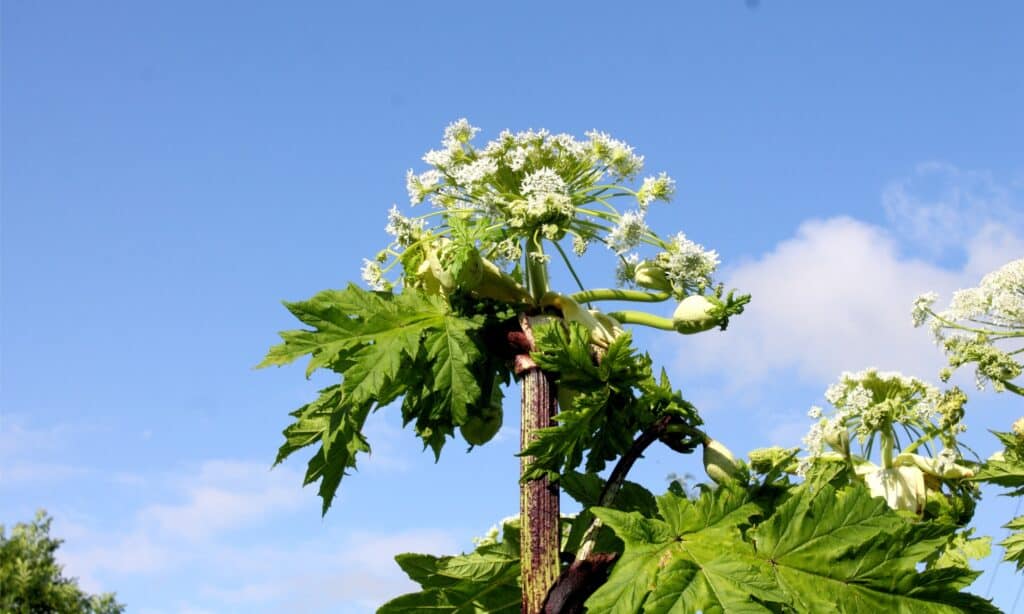
Giant hogweed is one of the most dangerous plants that grow in Michigan.
©iStock.com/SailsKool
1. Giant Hogweed
- Botanical Name: Heracleum mantegazzianum
- Other Common Names: Hogsbane, giant cow parsley, giant cow parsnip, cartwheel flower, wild rhubarb
- Plant Description: Giant hogweed grows large leaves with deep lobes. Its sap-sticky green stems have reddish-brown splotches and rough white hairs. This plant also produces small white flowers that grow in umbrella-shaped clusters.
- Height at Maturity: 14-16 feet
- Habitat: Forest edges, floodplain forest, wet soil near streams and rivers, roadsides, yards, vacant lots
- Toxic Parts of the Plant: Avoid all parts of the giant hogweed, even if the plant is dead.
- Symptoms of Exposure: severe rash, severe burn, blisters that scar the skin, and lasting sensitivity to sunlight
Huge and covered with toxic sap, the giant hogweed is one of the most dangerous plants that grow in Michigan and other states across the US. This invasive species grows up to 16 feet tall and resembles cow parsnip and Queen Anne’s lace plants.
Toxins in Giant Hogweed
Touching any part of the giant hogweed plant could result in rashes that turn into severe burns on the skin. These conditions are caused mainly by the plant’s phytotoxic sap, which is most harmful to the skin in the sunlight. Phytotoxic sap makes our skin defenseless against painful sunburn.
Giant hogweed is on the USDA’s Federal Noxious Weed list, which makes it illegal to import this plant to the United States or transport it between states without having a proper permit.
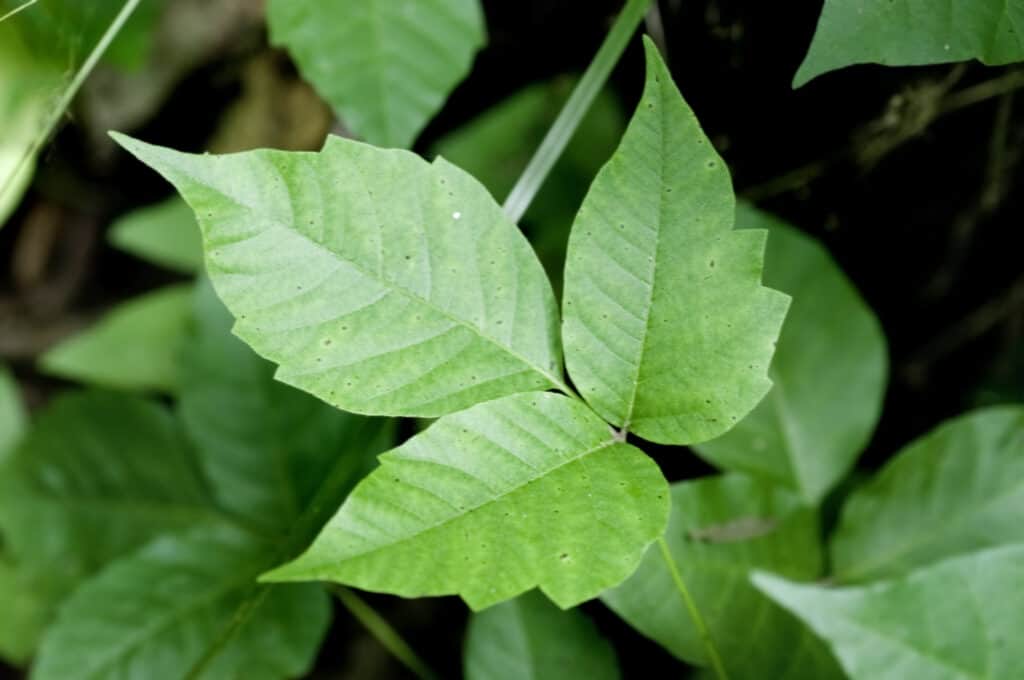
You can find poison ivy growing in sunny woods, forest edges, and along roadsides.
©Tim Mainiero/Shutterstock.com
2. Poison Ivy
- Botanical Name: Toxicodendron radicans
- Other Common Names: Markweed, Eastern poison ivy
- Plant Description: Poison ivy is a climbing or trailing plant with alternating glossy and dull green leaves with either toothed or smooth edges. The leaves grow in sets of three and turn reddish in the fall. And the plant also produces tiny yellowish-green flowers and white berries.
- Height at Maturity: Poison ivy can cling to structures with its roots to climb up to 75 feet, but the plant often trails along the ground.
- Habitat: Sunny wooded areas, forest edges, roadsides, and along trails
- Toxic Parts of the Plant: Avoid all parts of poison ivy, even if the plant is dead.
- Symptoms of Exposure: Itchy red rash, swelling, and blisters could result from touching poison ivy. Also, difficulty breathing could become a symptom of inhaling the smoke from burning poison ivy plants.
Poison ivy is one of the most famous dangerous plants that grow in Michigan. According to Mayo Clinic, poison ivy produces an oily resin called urushiol which causes skin rashes, swelling, and blisters. Urushiol is also the compound in poison oak and poison sumac that causes similar uncomfortable allergic reactions.
Dangerous poison ivy plants usually grow as ground cover in wooded areas where sunlight can filter through the vegetation around the plant.
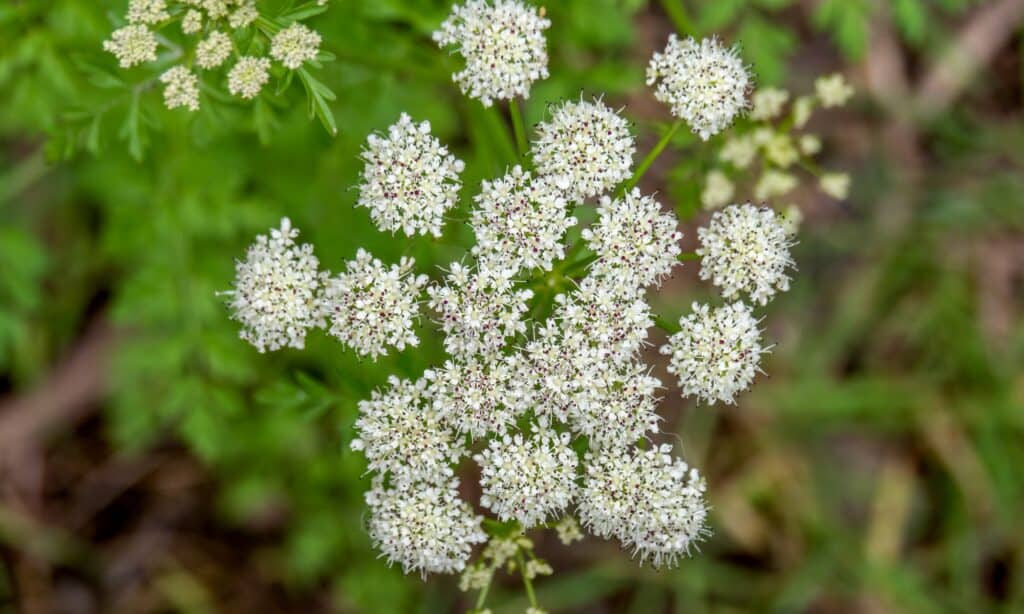
Don’t touch any part of the poison hemlock, even if the plant is dead, due to its toxicity.
©iStock.com/Goldfinch4ever
3. Poison Hemlock
- Botanical Name: Conium maculatum
- Other Common Names: Poison parsley, deadly hemlock, spotted hemlock, California hemlock, Nebraska hemlock, European hemlock
- Plant Description: Small, upright umbrella-shaped flower clusters grow from this tall plant’s hollow stems with purple spots. Mature flowers become ridged green fruit that eventually turns dusty brown. Like giant hogweed, poison hemlock looks similar to Queen Anne’s lace and wild carrot plants.
- Height at Maturity: 4-9 feet
- Habitat: Meadows and fields, marshes, ditches, roadsides, and other areas with wet soil and shade
- Toxic Parts of the Plant: Avoid all parts of poison hemlock, even if the plant is dead.
- Symptoms of Exposure: Poison hemlock poisoning can cause sweating, dilated pupils, weakness, dry mouth, vomiting, confusion, rapid heartbeat, and tremors. Note that severe symptoms of hemlock poisoning can start to slow essential body functions down, like a slowed heartbeat, low blood pressure, muscle paralysis, and kidney failure. Get immediate emergency medical care if ingested.
Poison hemlock is one of the most harmful plants that grow in Michigan, so it is essential to stay clear of it. Though just touching the plant won’t usually cause a rash or serious reaction, extra precaution is vital with this plant. For example, you could develop hemlock poisoning through the skin from open wounds, minor cuts, or scrapes. It’s also possible to get hemlock poisoning in the mucus membranes of your eyes and nose.
Toxins in Poison Hemlock
Poison hemlock is a dangerous plant full of toxic alkaloids that could be fatal if ingested. These dangerous alkaloids include coniine.
Though treatments are available for hemlock poisoning, there currently is no antidote. So the surest way to survive hemlock poisoning is to avoid this dangerous plant completely.
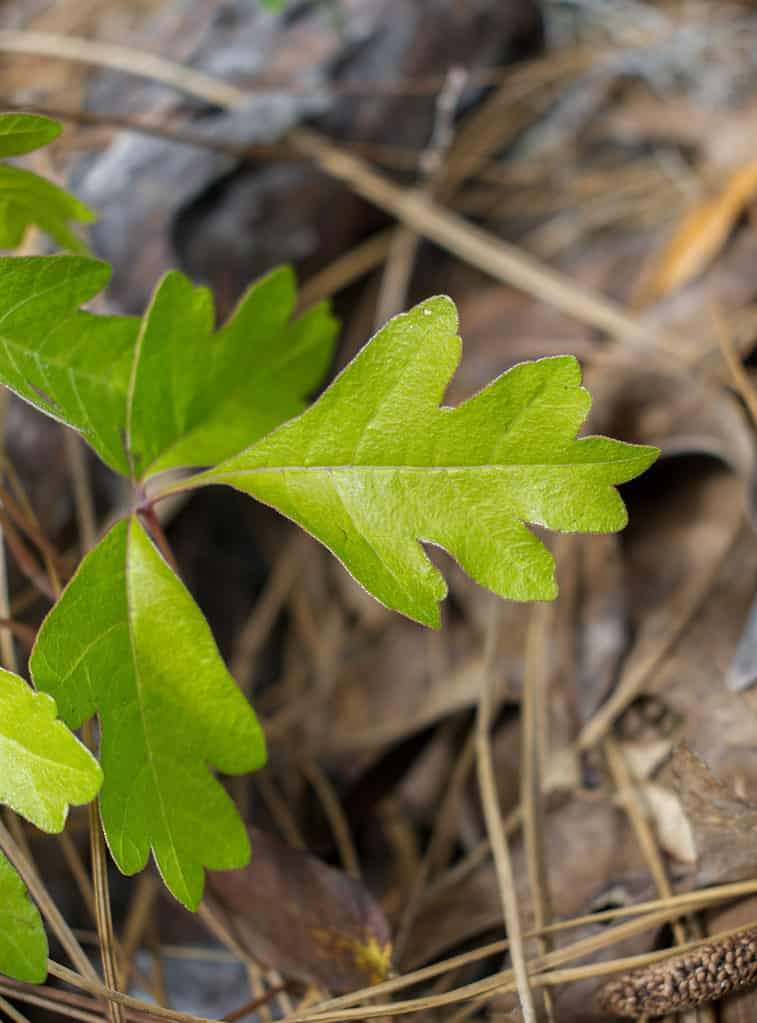
Atlantic or Eastern poison oak is a low-growing shrub that is sometimes confused for poison ivy.
©iStock.com/Dan Rieck
4. Poison Oak
- Botanical Name: Toxicodendron diversilobum or Toxicodendron pubescens
- Other Common Names: Pacific or Western poison oak ( for T. diversilobum), Atlantic or Eastern poison oak (for T. pubescens)
- Plant Description: Pacific poison oak has oval and lobed leaves that grow in three leaflets. It usually forms as a low-growing shrub but can also trail along the ground. Its new leaves are reddish and mature to green. Atlantic poison oak is a low-growing shrub that looks a lot like poison ivy. This variety of poison oak also has oval, lobed leaves that grow in a three-leaflet pattern on the stems. Both types of poison oak produce yellowish-green or green berries. Poison oak (either variety) leaves are shaped like the leaves of an oak tree and grow tiny hairs on their surface. Both plants produce little white flowers in spring.
- Height at Maturity: Pacific poison oak can grow up to 12 feet high or more and can trail along the ground for more than 80 feet. Atlantic poison oak typically grows up to 4 feet high but can also grow 10 feet tall or more.
- Habitat: Poison oak grows in woodlands, grasslands, near the edge of rivers, and coastal areas. And poison oak prefers wetter soil under some shade, so it often grows beneath trees near water.
- Toxic Parts of the Plant: Avoid all parts of poison oak, even if the plant is dead.
- Symptoms of Exposure: Similar to poison ivy, touching poison oak can cause an itchy red rash, swelling, and blisters. Symptoms could last for several days.
There is some debate about whether poison oak is worth mentioning as one of the dangerous plants that grow in Michigan. The reason is that the two types of poisonous oak mainly grow outside of the midwestern states of the US.
- Pacific Poison Oak (T. diversilobum) is native to North America but mainly grows along the west coast, from British Columbia through the US and into Mexico.
- Atlantic Poison Oak (T. pubescens) is also native to North America but grows mainly in the Southeast United States.
Some resources claim there’s no poison oak growing in Michigan, or it’s rare. But, at the same time, other reliable sources say this poisonous plant is spreading across the state. So be on the lookout for any variety of poison oak because this plant has the same toxic oil (urushiol) as poison ivy and poison sumac.
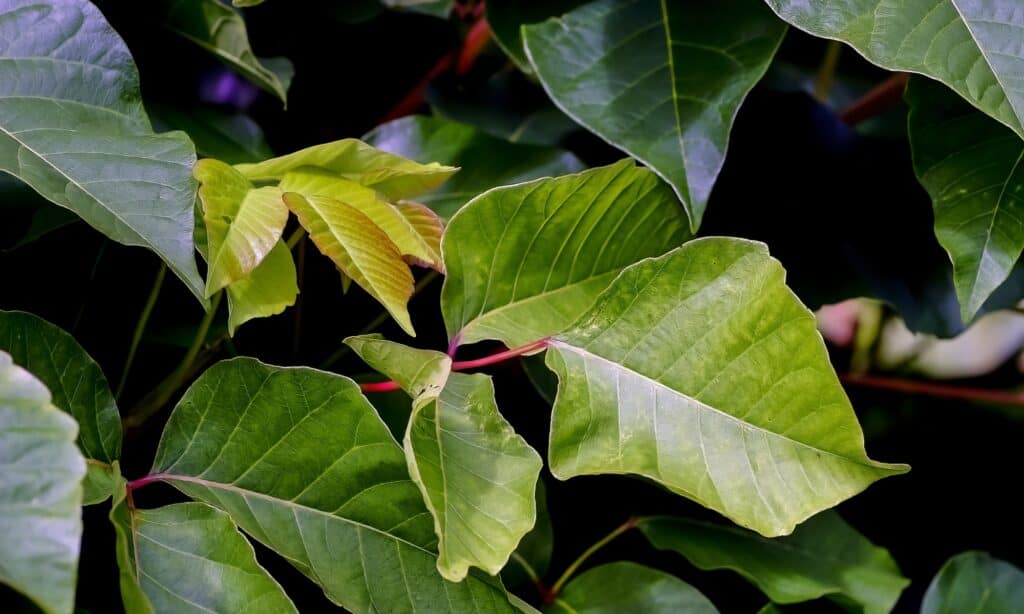
Touching poison sumac can cause a burning rash and fluid-filled blisters.
©iStock.com/Werner Meidinger
5. Poison Sumac
- Botanical Name: Toxicodendron vernix
- Other Common Names: Thunderwood, shrub oak, swamp sumac, poison elder, poison tree
- Plant Description: The poison sumac plant is a woody shrub that can look like a small tree. It grows clusters of smooth oval leaves (with 7-13 leaflet pairs in a row) on red stems, plus greenish or white berries that hang downward.
- Height at Maturity: 5-25 feet tall
- Habitat: Marshes, bogs, and swampy areas with wet soil
- Toxic Parts of the Plant: Avoid all parts of poison sumac, even if the plant is dead.
- Symptoms of Exposure: Red and itchy rashes, raised bumps, swelling, burning sensations, and fluid-filled blisters.
Like poison ivy and poison oak, the dangerous plant called poison sumac contains the toxic compound urushiol. However, poison sumac has a much higher toxicity than other plants containing urushiol because of its unique chemical makeup. So poison sumac can cause poisoning symptoms more severe than those caused by poison ivy or poison oak.
Fortunately, poison sumac is less common in Michigan and other states than similar dangerous plants. However, they all tend to grow near wet soil areas, like bogs, marshes, and swamps.
Poison sumac is especially attractive in the fall when its leaves turn orange and red. But don’t be fooled by the autumn beauty of this scraggly bush! Though it might seem safe because birds like chickadees and warblers eat its seeds, poison sumac should not be touched at any time of year.
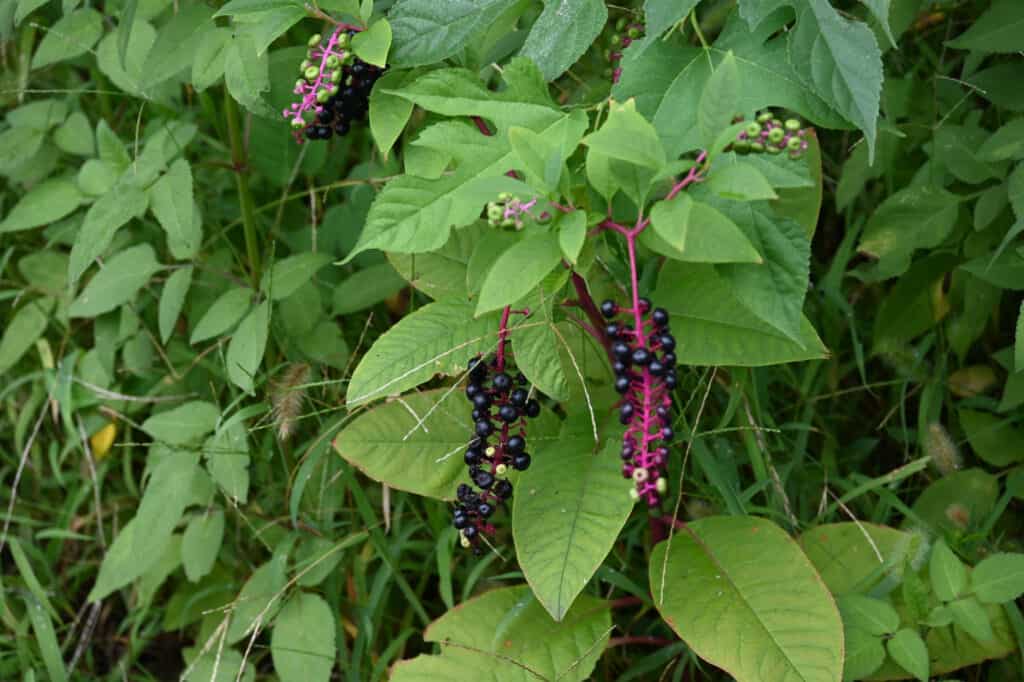
Keep children, pets, and livestock away from poisonous pokeweed plants and their berries.
©tamu1500/Shutterstock.com
6. Pokeweed
- Botanical Name: Phytolacca Americana
- Other Common Names: American pokeberry, poke salad, American nightshade, pigeon berry, skoke
- Plant Description: Pokeweed is a tall, upright, branching plant with smooth, reddish-purple stems. Its long oval leaves are dark green and shiny, and it produces long-hanging clusters of dark berries that develop from the plant’s green, white, or pinkest flowers. The berries mature to dark purple in late summer to early fall. Pokeweed plants are sometimes confused with a similar plant called knotweed. However, pokeweed usually produces a lot more berries than knotweed.
- Height at Maturity: Average height is 4-10 feet tall, but some pokeweed plants grow taller
- Habitat: This plant grows in woodlands, the edge of forests, pastures, fields, and sometimes in your yard. Pokeweed loves to grow at the opening or edge of its favorite habitats.
- Toxic Parts of the Plant: Avoid all parts of pokeweed, even if the plant is dead.
- Symptoms of Exposure: Touching pokeweed can result in an itchy red rash and blisters that last up to several days. Eating any part of this plant can cause mild to severe symptoms, including headache, diarrhea, convulsions, muscle spasms, vomiting, difficulty breathing, and loss of consciousness.
Though it’s a beautiful ornamental plant with pretty berries, don’t touch any part of pokeweed without wearing gloves and protective clothing. American pokeweed is a highly toxic plant if ingested and can cause blistering skin rashes when touched. As with any poisonous plant, there’s also the risk of getting toxins in your bloodstream through cuts or scrapes on your skin. So avoid brushing up against this plant as much as possible.
It’s essential to keep children, pets, and livestock away from pokeweed because of their temptation to pick and eat this plant’s poisonous berries. The risk of children and animals getting pokeweed poisoning is a major reason why this is one of the most dangerous plants that grow in Michigan.
Toxins in Pokeweed
According to Vanderbilt University Medical Center, pokeweed’s phytolacca toxin, additional saponins, and mitogen content make this plant toxic.
Though the berries of this plant are less toxic than its other parts, the raw berries can still cause dangerous reactions. However, many birds love and devour pokeweed berries and might get to them first! Bluebirds, crows, cardinals, and starlings are just a handful of the many birds that flock to pokeweed shrubs.

Stinging nettle is a perennial herb with needle-like hairs on the leaves and stems.
©iStock.com/Dmitri Zelenevski
7. Stinging Nettle
- Botanical Name: Urtica dioica
- Other Common Names: Common nettle, nettle leaf
- Plant Description: Stinging nettle (a perennial herb) has long, heart-shaped leaves with serrated edges that grow opposite each other on a tall green stalk. This perennial herb’s stems and leaves are covered with tiny needle-sharp hairs, some of which are long and cause a painful sting when brushed against the skin. In addition, stinging nettle produces tiny dangling clusters of greenish-yellow flowers.
- Height at Maturity: 3-7 feet tall
- Habitat: In wet soils near rivers and streams, ditches, forest edges and clearings, mountain slopes
- Toxic Parts of the Plant: Avoid touching the leaves and stems without wearing thick gloves. For information about stinging nettle as an edible herb, contact your local county extension office.
- Symptoms of Exposure: Touching stinging nettle plants can cause redness, swelling, hives, and burning or tingling pain that lasts up to a few days.
You’ll know you’ve found a stinging nettle plant if you accidentally brush up against one because of its stinging needle-like hairs. Yet of all the dangerous plants that grow in Michigan, stinging nettle symptoms might not last as long. For example, stinging nettle symptoms usually end in less than a week. In contrast, poison ivy symptoms might take 2-3 weeks to clear up entirely. But that doesn’t mean it’s more fun to get stung by this plant!
The longest hairs on stinging nettle stems and leaves break off the plant and stick like needles into your skin. Did that description make you cringe? It makes us cringe too!
Toxins in Stinging Nettle
The pain caused by stinging nettle hairs poking your skin is due to chemicals that create lasting discomfort. For example, acetylcholine, serotonin, and histamine (all neurotransmitters) from these sharp hairs cause pain and inflammation. Additionally, acids in the stinging hairs – like formic, oxalic, and tartaric acids – help keep the discomfort going for a few days.
Like most dangerous Michigan plants on this list, stinging nettles thrive in wet soil and marshy areas. Some nettle plant varieties don’t cause harm when touched, but stinging nettles are best handled with thick gloves or not at all.

Touching wild parsnips in the sunlight can cause the plant’s sap to burn and blister your skin.
©R. A. Nonenmacher / CC BY-SA 4.0 – License
8. Wild Parsnip
- Botanical Name: Pastinaca sativa
- Other Common Names: Wild parsnip, parsnip
- Plant Description: Wild parsnip is a tall, upright plant with hairy, grooved stems and umbels (flat-topped clusters) of tiny yellow flowers. Its yellowish-green leaves are long and oval, with toothed (jagged) edges.
- Height at Maturity: 3-5 feet tall
- Habitat: Sunny areas of wetlands, prairies, grassy plains (savannas), and along roadsides
- Toxic Parts of the Plant: Wild parsnip produces a toxic sap on mainly its leaves and shoots. So because of the easy transfer of the sap, it’s best to avoid touching any part of this plant with bare skin.
- Symptoms of Exposure: Touching wild parsnip can cause redness, rash, blisters, and severe sunburn. Symptoms are extreme when the skin is exposed to sunlight when touching the plant.
Wild parsnip is a root vegetable and an invasive plant that you shouldn’t touch with bare skin. Fortunately, just like after getting a bad sunburn, the symptoms of wild parsnip poisoning start to ease after a few days.
Even though it’s a root vegetable, don’t grow wild parsnip on your property. If you discover a patch of wild parsnip, don’t touch it; take photos and note the location of the plants in order to report it.
In Michigan, you can report invasive plant sightings directly to the Midwest Invasive Species Information Network (MISIN). Or contact your local county’s extension office for more guidance.
Toxins in Wild Parsnip
Wild parsnip is a dangerous Michigan plant because it contains toxic compounds called furanocoumarins. When exposed to sunlight, these compounds cause human and animal skin to become overly sensitive to ultraviolet light and therefore burn easily.
Beware These Dangerous Plants That Grow in Michigan
Awareness of the dangerous Michigan plants you might encounter in various natural habitats helps make your nature walks and outdoor activities much safer! Take precautions by wearing protective clothing, carrying a small first aid kit, and knowing how to treat mild symptoms quickly.
And remember this important rhyme – if it has leaves of three, leave it be! That will at least help you avoid poison ivy and oak since their leaves grow in three leaflets.
You might also tuck a small plant identification guide in your backpack for a handy way to recognize all the other dangerous plants that grow in Michigan. And download a trustworthy plant identification app for those foraging trips where you might have some spotty cell service in the woods!
Summary of the 8 Dangerous Plants That Grow in Michigan
Here’s a summary of the 8 dangerous plants that grow in Michigan and the symptoms of exposure:
| Number | Plant | Symptoms |
|---|---|---|
| 1 | Giant Hogweed | severe rash, severe burn, blisters that scar the skin, lasting sensitivity to sunlight |
| 2 | Poison Ivy | Itchy red rash, swelling, blisters |
| 3 | Poison Hemlock | sweating, dilated pupils, weakness, dry mouth, vomiting, confusion, rapid heartbeat, tremors |
| 4 | Poison Oak | itchy red rash, swelling, blisters |
| 5 | Poison Sumac | Red and itchy rashes, raised bumps, swelling, burning sensations, fluid-filled blisters |
| 6 | Pokeweed | Touching: itchy red rash and blisters; Eating: headache, diarrhea, convulsions, muscle spasms, vomiting, difficulty breathing, loss of consciousness |
| 7 | Stinging Nettle | redness, swelling, hives, burning or tingling pain |
| 8 | Wild Parsnip | redness, rash, blisters, severe sunburn |
The photo featured at the top of this post is © iStock.com/Mieszko9
Thank you for reading! Have some feedback for us? Contact the AZ Animals editorial team.






